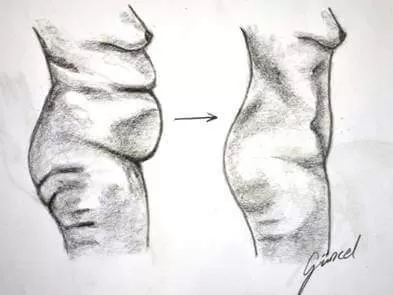

Abdominoplasty or “tummy tuck” is a cosmetic surgical procedure used to provide a smoother and firmer abdominal profile. The operation involves the removal of excess skin and fat from the lower abdomen and the repair of weakened or separated muscles and fascia to correct the middle and lower abdominal wall, muscles and fascia. This operation is especially useful for women who have given birth several times, have stretch marks and sagging abdominal skin, and have weakened abdominal muscles. This type of operation is usually applied to people with sagging abdominal area after heredity, pregnancy, aging and significant weight loss. Generally, a tummy tuck will improve your appearance and your self-confidence.

Abdominoplasty is not a treatment for obesity. Obese people should lose a certain amount of weight before this operation. Abdominoplasty operations can be performed together with body contour correction (aesthetic breast operations, liposuction, etc.) or some other operations (uterus, ovarian operations, etc.).
During the interview, your current complaints and your expectations after the operation are evaluated.
Afterwards, your general health status, the amount and distribution of fat in the abdominal area, the sagging and excessive abdominal skin and skin quality are evaluated.
During this examination, information is obtained about the surgical procedures and diseases you have undergone, your current health problems (diabetes, etc.), your habits (smoking, drinking, etc.) and the medications you use (aspirin, tranquilizers, etc.).
As a result of your expectations and examination findings, the type of tummy tuck operation is decided alone or in combination with liposuction or only liposuction operation.
You will need someone to help you on the day of the operation and for the next few days.
Aspirin and derivative medications are stopped one week before the operation. (Do not stop your regular medication without consulting your doctor)
You should not stay in the sun too long during this period. A cold or other infection may cause your operation to be postponed.
It is recommended not to smoke for a while before and after the operation.
On the day of the operation, do not wear make-up, hair gel, wear comfortable clothes, leave your jewelry at home.
Nothing should be eaten or drunk 6 hours before the operation.
You should be at the hospital about an hour before the operation.
When you arrive at your reserved room, you will be given an oral medication if you wish and this will relax you.
Full tummy tuck
The incision is made from one buttock to an incision line that extends from one buttock to the opposite buttock, but can be hidden in a bikini swimsuit.
Laxity in the muscles and fascia in the lower, middle and upper abdominal wall is repaired and bloating is eliminated.
The excess skin and fat layer is stretched downwards and the excess is removed.
The navel is adapted to its new place.
Liposuction can be performed additionally to give a smoother contour. Partial tummy tuck (mini abdominoplasty)
A smaller incision is made between both groins.
The laxity in the muscles and fascia of the lower abdominal wall is repaired and bloating is eliminated.
The skin is stretched downwards and the excess skin and fat layer are removed.
The umbilical stalk may not be relocated.
Liposuction can often be used to correct the transition area.Extended tummy tuck
An incision line is created that extends from one buttock to the opposite buttock, but can be hidden in a bikini swimsuit
It includes a full tummy tuck and a lifting operation on the outer side of the upper thigh.High side tummy tuck
In a conventional tummy tuck, the fascia and muscles are tightened vertically.
In high tension side abdominoplasty, in addition to tightening in the vertical line, the muscle is also tightened horizontally.
With this technique, a significantly flat abdomen is achieved, eliminating the flabby and bulging abdomen. Circumferential tummy tuck
In addition to an extended tummy tuck, it also includes a lift in the buttocks.
The incision completely encircles the lumbar region.
This procedure is very suitable for patients after major weight loss.
After the operation, a dressing is applied and a special abdominal corset is worn to minimize swelling and support the abdomen. There may be swelling and pain in the abdomen for the first few days and this is controlled with painkillers. Drains are removed after 1-3 days on average. You will stay in the hospital for about 1-3 days. You can return to work after 2-4 weeks. The scar will appear red and pinky for the first 3-6 months, it may take 9 months to 1 year for the scar to flatten and fade. Your acceptable scar is created to be placed under the bikini line.
The “abdominal correction” operation is performed on thousands of people every year.
After the third week, you will be more aware of the new shape the operation has given your body and generally the tummy tuck will improve your appearance and your confidence.
Like most cosmetic surgeries, the cost of a tummy tuck can vary widely. The cost of this operation varies according to various factors such as the age, weight and health status of the patient, as well as the training received by the plastic surgeon, as well as the location and name of the hospital where he or she works.
The cost may include:
-Surgeon’s fee
-Hospital or surgical facility costs
-Anesthesia fee
-Medications
-Special clothing after the operation
-Medical tests before and after the operation, such as




Copyright © 2026 Tüm Hakları Saklıdır.
SEO:
